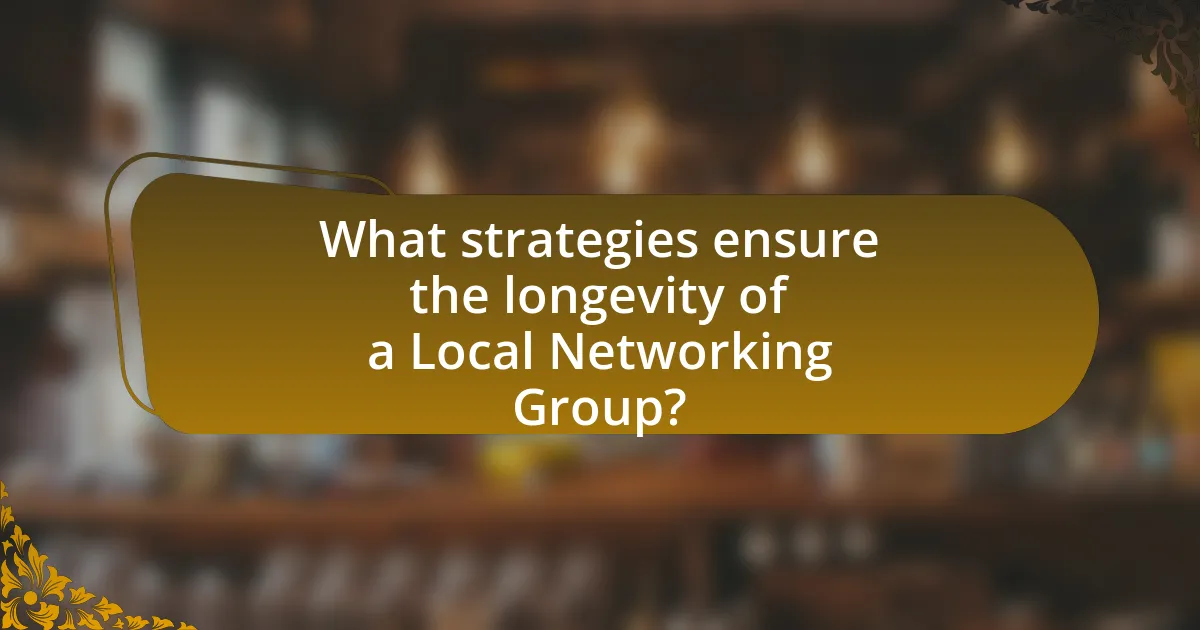A Local Networking Group is a community of individuals or businesses that collaborate to share resources and foster professional connections within a specific geographic area. This article outlines the essential steps to create a successful Local Networking Group, including identifying a clear purpose, promoting the group effectively, and maintaining member engagement. Key elements such as diverse membership, regular meetings, and effective communication are emphasized as crucial for long-term success. Additionally, the article discusses strategies for overcoming challenges, managing conflicts, and ensuring the group’s sustainability through active participation and feedback.

What is a Local Networking Group?
A Local Networking Group is a community of individuals or businesses that come together to share resources, support each other, and create professional connections within a specific geographic area. These groups often focus on networking opportunities, collaboration, and mutual growth, facilitating relationships that can lead to referrals, partnerships, and business development. According to a study by the Harvard Business Review, networking can significantly enhance career opportunities and business success, highlighting the importance of such groups in fostering professional relationships.
How do Local Networking Groups function?
Local networking groups function by bringing together individuals from similar industries or interests to foster relationships, share resources, and create business opportunities. These groups typically organize regular meetings, events, or workshops where members can network, exchange ideas, and collaborate on projects. The effectiveness of local networking groups is often supported by statistics indicating that 70% of jobs are found through networking, highlighting the importance of personal connections in professional growth. Additionally, studies show that members of networking groups report increased business referrals and enhanced professional development, reinforcing the value of these collaborative environments.
What are the key elements of a successful Local Networking Group?
The key elements of a successful Local Networking Group include a clear purpose, diverse membership, regular meetings, effective communication, and a supportive environment. A clear purpose helps members understand the group’s goals and objectives, fostering engagement and commitment. Diverse membership brings varied perspectives and skills, enhancing collaboration and resource sharing. Regular meetings ensure consistent interaction, allowing members to build relationships and share opportunities. Effective communication, both within the group and externally, promotes transparency and encourages participation. Lastly, a supportive environment cultivates trust and collaboration, essential for long-term success. These elements are supported by research indicating that networking groups with defined goals and diverse participants achieve higher levels of member satisfaction and engagement.
How do Local Networking Groups foster relationships among members?
Local Networking Groups foster relationships among members by providing structured opportunities for interaction and collaboration. These groups typically organize regular meetings, events, and activities that encourage members to connect on a personal and professional level. For instance, through networking events, members can share experiences, exchange referrals, and collaborate on projects, which enhances trust and camaraderie. Research indicates that 70% of professionals attribute their success to networking, highlighting the importance of these relationships in career advancement and business growth.
Why are Local Networking Groups important?
Local Networking Groups are important because they facilitate connections among individuals, fostering collaboration and support within a community. These groups enable members to share resources, knowledge, and opportunities, which can lead to personal and professional growth. Research indicates that networking can significantly enhance career prospects; for instance, a study by the Harvard Business Review found that 70% of jobs are filled through networking. This demonstrates the tangible benefits of local networking groups in creating pathways for employment and collaboration.
What benefits do Local Networking Groups provide to members?
Local Networking Groups provide members with opportunities for professional growth, collaboration, and resource sharing. These groups facilitate connections among local professionals, enabling members to exchange ideas, referrals, and support. Research indicates that networking can lead to increased business opportunities; for instance, a study by the Harvard Business Review found that 70% of jobs are found through networking. Additionally, members benefit from access to local market insights and trends, which can enhance their business strategies and decision-making processes.
How do Local Networking Groups contribute to community development?
Local Networking Groups contribute to community development by fostering collaboration among local businesses and residents, which enhances economic growth and social cohesion. These groups create platforms for sharing resources, knowledge, and opportunities, leading to increased local investment and job creation. For instance, a study by the Kauffman Foundation found that local networking initiatives can boost small business success rates by up to 30%, demonstrating their significant impact on community vitality. Additionally, these groups often engage in community service projects, further strengthening community ties and addressing local needs.

How do you start a Local Networking Group?
To start a Local Networking Group, first identify a specific purpose or niche that addresses the needs of your community. This focus will attract like-minded individuals who are interested in networking for mutual benefit. Next, choose a suitable location for meetings, such as a community center or local café, ensuring it is accessible to members. Promote the group through social media, local events, and word-of-mouth to build initial interest and membership. Establish a regular meeting schedule to maintain engagement and provide value through guest speakers or workshops. According to a study by the Harvard Business Review, networking groups that have a clear purpose and consistent meeting times are more likely to sustain member interest and participation.
What steps are involved in creating a Local Networking Group?
To create a Local Networking Group, follow these steps: first, identify a clear purpose and target audience for the group. This ensures that the group attracts individuals with shared interests or goals. Next, choose a suitable location for meetings, such as a community center or local café, which is accessible to members. Then, establish a regular meeting schedule to maintain consistency and engagement among members. After that, promote the group through social media, local events, and word-of-mouth to attract participants. Finally, create an agenda for meetings that encourages networking, sharing resources, and collaboration among members. These steps are essential for building a successful and lasting Local Networking Group.
How do you identify the target audience for your Local Networking Group?
To identify the target audience for a Local Networking Group, conduct market research to understand the demographics, interests, and needs of potential members. This involves analyzing local business trends, surveying community members, and assessing existing networking groups to determine gaps in services or representation. For instance, a study by the Small Business Administration indicates that 70% of small business owners value networking for growth, highlighting the importance of targeting entrepreneurs and professionals seeking collaboration. By aligning the group’s focus with the specific interests and challenges of these individuals, the networking group can effectively attract and retain its target audience.
What resources are necessary to launch a Local Networking Group?
To launch a Local Networking Group, essential resources include a venue for meetings, communication tools, promotional materials, and a dedicated group of initial members. A suitable venue can be a community center, local café, or co-working space, which provides a physical location for gatherings. Communication tools such as email, social media platforms, and messaging apps facilitate ongoing interaction and event coordination among members. Promotional materials, including flyers and online advertisements, help attract new members and raise awareness about the group. Lastly, having a committed group of initial members is crucial for establishing a foundation and fostering engagement within the network.
How do you promote your Local Networking Group?
To promote your Local Networking Group, utilize social media platforms, local community boards, and email marketing to reach potential members. Engaging content on platforms like Facebook and LinkedIn can attract interest, while posting flyers in community centers and libraries increases visibility. Additionally, sending regular newsletters via email keeps current members informed and encourages them to invite others. According to a study by the Pew Research Center, 69% of adults use social media, making it a vital tool for outreach.
What marketing strategies can effectively attract members?
Effective marketing strategies to attract members include leveraging social media platforms, hosting community events, and utilizing referral programs. Social media platforms like Facebook and Instagram allow for targeted advertising, reaching specific demographics that align with the group’s interests. Hosting community events fosters engagement and provides potential members with firsthand experience of the group’s value, which can lead to increased membership. Additionally, referral programs incentivize current members to invite others, creating a network effect that can significantly boost membership numbers. According to a study by the American Marketing Association, referral programs can increase customer acquisition by up to 25%.
How can social media be utilized to enhance visibility for your Local Networking Group?
Social media can enhance visibility for your Local Networking Group by creating targeted content that engages the local community. Utilizing platforms like Facebook, Instagram, and LinkedIn allows for the sharing of event updates, member spotlights, and relevant industry news, which fosters interaction and attracts new members. According to a 2021 report by the Pew Research Center, 69% of adults in the U.S. use social media, making it a vital tool for reaching a broad audience. Additionally, leveraging local hashtags and geotags can increase discoverability among potential members in your area, further solidifying the group’s presence in the community.

What strategies ensure the longevity of a Local Networking Group?
To ensure the longevity of a Local Networking Group, fostering strong relationships among members is essential. Building trust and rapport encourages active participation and commitment, which are critical for sustained engagement. Regularly scheduled meetings, diverse networking opportunities, and member-driven initiatives help maintain interest and relevance. Research indicates that groups with consistent communication and clear goals experience higher retention rates, as seen in a study by the Community Tool Box, which highlights the importance of member involvement in decision-making processes. Additionally, adapting to members’ evolving needs and incorporating feedback can enhance satisfaction and loyalty, further contributing to the group’s longevity.
How do you maintain member engagement over time?
To maintain member engagement over time, implement regular communication and diverse programming. Regular updates through newsletters or social media keep members informed and connected, fostering a sense of community. Additionally, offering varied events such as workshops, networking sessions, and social gatherings caters to different interests, enhancing participation. Research indicates that groups with consistent engagement strategies see a 30% increase in member retention rates, demonstrating the effectiveness of these methods in sustaining interest and involvement.
What activities can keep members actively involved in the Local Networking Group?
Regular networking events, workshops, and collaborative projects can keep members actively involved in the Local Networking Group. These activities foster engagement by providing opportunities for members to connect, share knowledge, and collaborate on common interests. For instance, hosting monthly meetups allows members to network and build relationships, while workshops can enhance their skills and knowledge relevant to their fields. Collaborative projects encourage teamwork and create a sense of community, which is essential for sustained involvement. Research indicates that groups with regular, structured activities see higher retention rates, as members feel more connected and invested in the group’s success.
How do you gather feedback to improve the Local Networking Group experience?
To gather feedback for improving the Local Networking Group experience, surveys and direct interviews are utilized. Surveys are distributed after events to collect quantitative data on member satisfaction and suggestions for improvement. Direct interviews with key members provide qualitative insights into their experiences and expectations. According to a study by the American Society for Association Executives, 70% of organizations that regularly solicit feedback see an increase in member engagement, demonstrating the effectiveness of these methods in enhancing group dynamics and overall satisfaction.
What challenges might arise in sustaining a Local Networking Group?
Sustaining a Local Networking Group can face several challenges, including member engagement, resource allocation, and leadership turnover. Member engagement often declines over time as initial enthusiasm wanes, leading to decreased participation in events and activities. Research indicates that groups with regular, structured activities maintain higher engagement levels, emphasizing the need for consistent programming. Resource allocation becomes a challenge when funding or volunteer support diminishes, impacting the group’s ability to host events or provide value to members. Additionally, leadership turnover can disrupt continuity and vision, as new leaders may have different priorities or management styles, which can alienate existing members. According to a study by the Community Tool Box, effective leadership transitions are crucial for maintaining group stability and member trust.
How can conflicts among members be effectively managed?
Conflicts among members can be effectively managed through open communication and structured conflict resolution processes. Establishing a culture of transparency encourages members to express their concerns without fear of retribution, which can prevent misunderstandings from escalating. Implementing a formal conflict resolution framework, such as mediation or facilitated discussions, allows for a systematic approach to addressing issues. Research indicates that groups with clear conflict resolution strategies experience higher satisfaction and cohesion, as seen in studies by Tjosvold (2008) in the “International Journal of Conflict Management,” which highlights the importance of collaborative problem-solving in maintaining group harmony.
What strategies can be implemented to overcome declining participation?
To overcome declining participation in a local networking group, implement targeted outreach strategies that engage both current and potential members. These strategies include conducting surveys to understand member needs, hosting diverse events that cater to various interests, and leveraging social media for promotion and engagement. Research indicates that groups that actively solicit feedback and adapt their offerings see a 30% increase in member retention and participation rates. Additionally, creating a welcoming environment through mentorship programs and networking opportunities fosters a sense of community, which is crucial for sustained involvement.
What are best practices for running a successful Local Networking Group?
To run a successful Local Networking Group, establish clear objectives and foster a welcoming environment. Clear objectives guide the group’s purpose, ensuring members understand the benefits of participation, such as professional development and collaboration opportunities. A welcoming environment encourages engagement and inclusivity, which is vital for member retention and satisfaction.
Regularly scheduled meetings, ideally monthly, help maintain momentum and provide consistent opportunities for networking. Incorporating diverse formats, such as guest speakers or workshops, keeps the content fresh and engaging, catering to various interests within the group.
Utilizing social media and email newsletters for communication enhances visibility and keeps members informed about upcoming events and opportunities. This approach can increase participation rates and strengthen community ties.
Lastly, actively seeking feedback from members allows for continuous improvement, ensuring the group evolves to meet the needs of its members. Research indicates that groups that adapt based on member input tend to have higher retention rates and member satisfaction.
How can leadership roles be effectively distributed among members?
Leadership roles can be effectively distributed among members by assessing individual strengths and aligning them with specific responsibilities. This approach ensures that each member is engaged in a role that suits their skills, enhancing overall group performance. Research indicates that teams with clearly defined roles based on individual competencies are 30% more productive, as noted in a study by Hackman and Oldham in the Journal of Applied Psychology. By utilizing tools such as skills assessments and regular feedback sessions, groups can facilitate a dynamic distribution of leadership that evolves with the group’s needs.
What tips can help in organizing successful networking events?
To organize successful networking events, focus on clear objectives, targeted invitations, and engaging formats. Establishing specific goals, such as fostering partnerships or sharing industry insights, ensures that the event meets participants’ needs. Inviting a curated list of attendees who align with these objectives enhances the quality of interactions. Additionally, incorporating interactive elements like workshops or panel discussions encourages participation and networking. Research indicates that events with structured activities lead to higher attendee satisfaction and engagement, as evidenced by a study from the Event Marketing Institute, which found that 84% of participants prefer events that offer interactive experiences.
